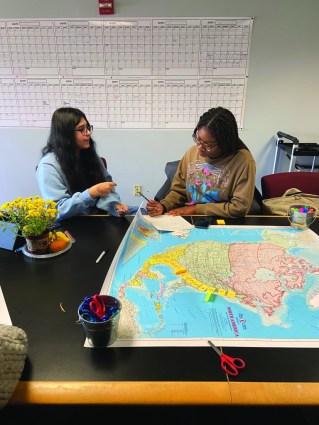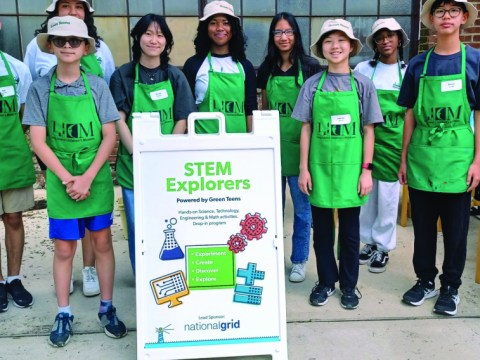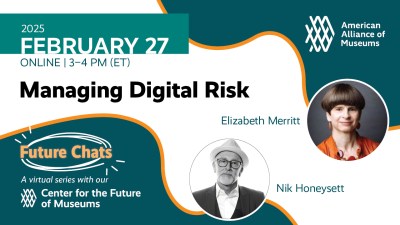
This article originally appeared in Museum magazine’s March/April 2024 issue, a benefit of AAM membership.
Through reflective practice, the Green Teens volunteers at the Long Island Children’s Museum develop programming for visitors—and lifelong skills.
The Long Island Children’s Museum (LICM), located in a 40,000-square-foot historic airplane hangar on Museum Row in Garden City, New York, began as a dinner conversation among a group of Long Island parents. Thirty years later, the museum has grown into a community gathering place, welcoming over 300,000 visitors each year with a staff of approximately 36 full-time and 75 part-time employees.
Our engaging staff, cultural festivals, community access programs, theater performances, and 14 interactive exhibits fulfill our mission of connecting our communities’ children to a life of wonder, imagination, and exploration. While one-third of all visitors are under the age of 5, LICM is a fun and engaging experience for children and adults of all ages.
One of the key volunteering opportunities at LICM is the Green Teens program, which I oversee. Established in 2009 and funded by regional energy company National Grid, this program annually organizes a group of teenage volunteers from local high schools to work together to design, prototype, and lead play-based programs to engage visitors in science, nature, and sustainability topics. Through this program, the museum offers teens a chance to break down science topics into understandable pieces of information and develop public speaking, collaboration, and problem-solving skills. As a result, museum visitors learn about the importance of the natural world and environmental advocacy.

Program Basics
To become a Green Teen, interested students must fill out an application and attend an interview. The strongest candidates—those who exhibit a strong interest in science and sustainability, are able to work as part of a team, and are curious about learning—are accepted into the program at the beginning of the school year or the start of the summer. Once part of the program, they can continue throughout their high school experience. At any given time, we have between 12 and 16 Green Teens.
The teens meet one day each month throughout the school year and weekly during the summer months. Part of their day is spent developing future programming; thinking through the science themes, such as natural disasters, alternative energy, and habitat conservation, in small groups; and sharing their ideas for feedback. The Green Teens refine their ideas as a group, posing questions and testing activities.
The second half of the day is spent facilitating their previously planned activities on the museum floor (or outside in LICM’s outdoor exhibit, Our Backyard, during the summer). These activities have included a game that teaches what helps or hinders monarch butterflies as they make their fall migration to Mexico, an engineering activity where kids design a building that could withstand an earthquake, and a pumpkin dissection that helps participants hone their observational skills. At the end of the day, we come back together to discuss how the activities went, detailing any successes or challenges.
Teaching Reflective Practice
In overseeing the Green Teens, I have built a culture of reflective practice among the group. This set of habits builds moments of reflection into your work so that you can take stock of what you are trying to accomplish, what steps you have tried, and how the different pieces impact each other so that you are able to iterate. In my own career, I’ve had opportunities that have helped me understand the benefit of incorporating moments of reflection and slowing down to notice things, which has reinforced my desire to cultivate this practice in the Green Teens program. (For more on my reflective practice education, see the “My Reflective Practice Journey” sidebar at right.) I have developed the following approaches to reflecting that allow everyone to participate in the way that they are comfortable while we expand on our work at each meeting:
Using “think, pair, share.” With this strategy, I pose a question or a topic—for example, “Think about a time in your life when you learned something outside of school. What made it memorable?”—and allow the teens to think by themselves for a set amount of time. Having pen and paper for each person can be helpful. I then invite them to share their thoughts with one other person before facilitating a group conversation. This allows them the time and space to gather their own thoughts, lowers the stakes of sharing out loud by first inviting them to speak with just one person, and opens things up for group sharing.
Thinking on big paper. When we are brainstorming program ideas as a group, I bring out a very large sheet of kraft paper and invite the teens to write down all of their ideas or questions and physically move around the perimeter of the paper to see what their peers have written. This has been especially helpful when planning for our summer programming. I lead this brainstorming session at our training at the beginning of the summer and bring the paper to each weekly meeting thereafter. This helps the teens develop ideas over time, allows for connections between different people’s thoughts, and creates a space for everyone to participate, even if they are not at each meeting, since the activity spans a length of time.
Facilitating a wrap-up conversation. At the end of each program day, the entire group assembles to discuss what went well, what was a challenge, and what could be improved. The leaders of each activity share their own perspectives of the day, and notes are taken to refer to during the next prototyping session. Because we habitually have this conversation at the end of each day, the teens are thinking about these questions as they are leading their activities and have thoughtful input to share.
Encouraging individual reflections. In addition to having opportunities for teens to discuss things together, there is individual reflection time throughout the program. This serves two purposes: (1) it allows them the quiet space to think through reflection questions, such as “What is your goal for participating?” “What has been your biggest success this year?” and “What should change?” and (2) it gives me a more personal understanding of the teens’ interests and motivations. As I plan for the next program year, I take their feedback into consideration to make improvements to the training structure, the location of activities for maximum visitor participation, the science topics they want to explore, and more.
As I’ve incorporated these strategies over the past few years, I’ve seen a shift in the culture of our group and how the teens approach planning activities. Setting aside dedicated time to be reflective and weaving these habits throughout our meetings highlights this as an important aspect of the program and helps the teens build intentionality. Rather than quickly moving from one thing to the next, the Green Teens think through things, whether that is the best way to explain a complex science concept to a 5-year-old or the best materials to use in an activity.
This reflective practice also helps them exercise their voice. When teens are asked at the beginning of the program about their goals for participating, many say that they want to overcome their fear of public speaking or social anxiety. Giving them different opportunities to voice their thoughts allows them to take risks. By the end of the program year, these same teens will write that their biggest success is that they’ve been able to share their ideas out loud with their peers and contribute to group conversations.
In developing these habits, the teens are able to move through the iterative process of activity development, creating a better learning experience for museum visitors. Over their time in the program, they see that their feedback makes an impact.
Looking to the Future
Thanks to recent funding from PricewaterhouseCoopers, I am currently working on ways to expand the program to connect the current cohort of teens with alumni of the program. I have relied on our habits of reflection to help me shape these new experiences. The alumni and the current cohort have thoughtfully responded to reflection questions that explore how they want to be connected with the other group, their career aspirations, how participating in Green Teens has impacted them, and what they hope to learn by interacting with this larger group.
With this information, I am beginning to set up several ways to bring the current and former Green Teens together. Some participants who want a more in-depth connection will be paired with an alumni mentor with whom they will meet virtually to discuss topics like how to find internship opportunities, how to navigate making friends in college, and what goes into choosing a major. We will also have several alumni lunches, where Green Teens alumni who are local will meet up with the current cohort to share their personal experiences. I am also creating a contact list of all current and former Green Teens with their school, major, and, if they’ve already graduated college, their job. Current teens will then be able to reach out to alumni with specific questions.
As we work through this current iteration of the program, we will build on our reflective practice to continuously improve the experience. As we do so, I look forward to seeing more teens embrace the practice to create engaging programming for our visitors, develop more self-confidence, connect with other Green Teens participants, and successfully navigate the next steps of their lives.

MY Reflective Practice Journey
Reflective practice is a big part of what the Green Teens volunteers learn at the Long Island Children’s Museum (LICM). To impart this knowledge, I have had to embark on my own reflective journey.
In 2017, I, along with some LICM colleagues, attended a three-day workshop at the American Museum of Natural History to learn about Reflecting on Practice (RoP), a professional learning program developed by the Lawrence Hall of Science that engages participants in habits of reflection, relates learning research to practice, and nurtures a culture of reflection in the workplace. We left the workshop with the tools and curriculum we needed to implement RoP at LICM.
I had another opportunity to understand the benefits of slowing down to reflect when I was chosen as a 2019 Grosvenor Teacher Fellow through National Geographic and Lindblad Expeditions. Through this professional development opportunity for pre-K–12 educators, I participated in a 24-day expedition to the Falkland Islands, South Georgia (an island in the Atlantic), and Antarctica. I saw wildlife; hiked, skied, and kayaked across the landscapes; and learned the importance of slowing down to understand the complexity of our world. As part of the fellowship, I developed the temporary “Slow Down! Explore” exhibition for LICM.
Finally, my participation in the Fred Rogers Institute’s Educators’ Neighborhood has underscored the value of slowing down and reflecting. In watching and discussing episodes of Mr. Rogers’ Neighborhood, I’ve learned ways to be purposeful in my work and model reflection for the students I work with.
As I have built a reflective practice in my own work, I have been layering these experiences into the Green Teens program to help the teens build reflective habits, improve the programs we offer to visitors, and refine their experience in the program.








Comments